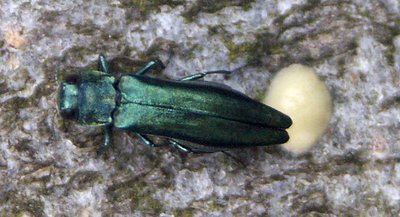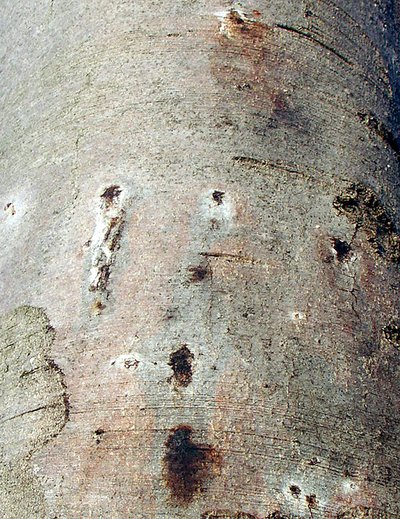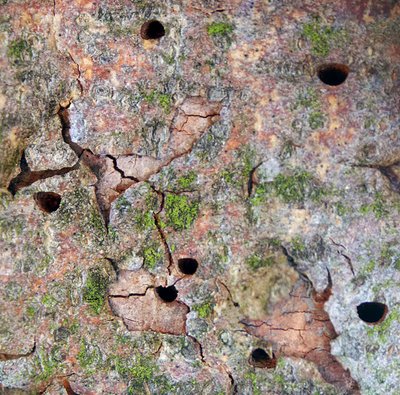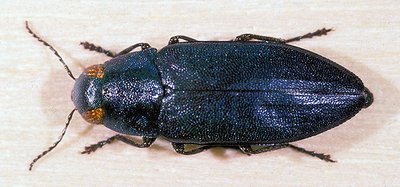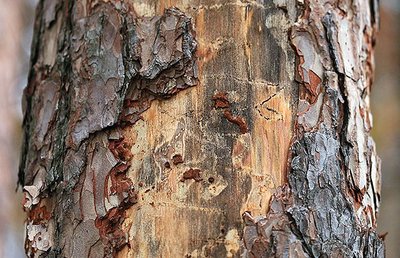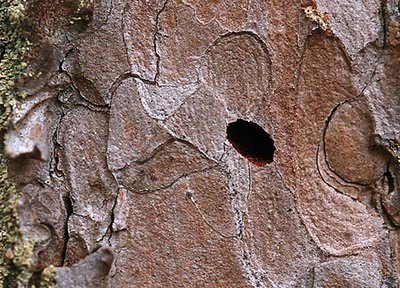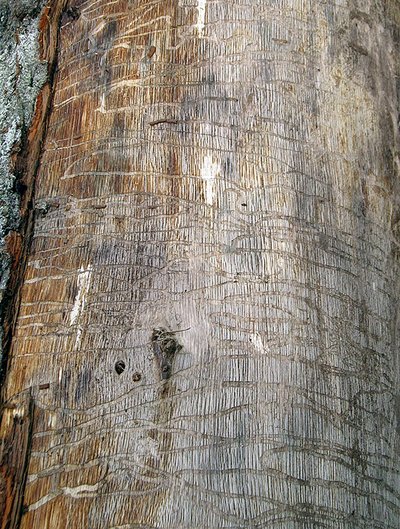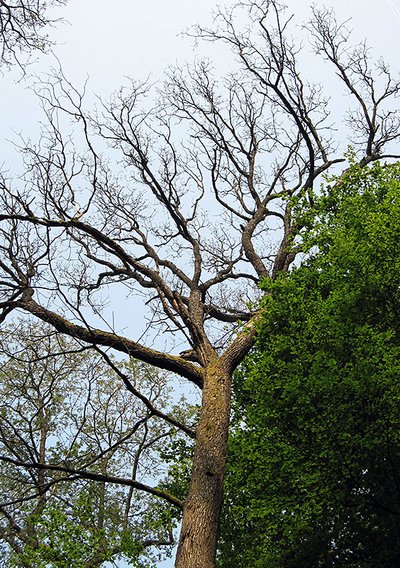Jewel beetles (Buprestidae) are heat-loving species that prefer the edges of forests, suddenly exposed trees, and sparse forest stands. They infest trees only if the trees have already been damaged by other insects or weakened severely by drought. Forest owners and foresters must therefore monitor the jewel beetle species more closely after dry summers, and in particular the beech splendour beetle (Agrilus viridis), the steelblue jewel beetle (Phaenops cyanea) and the oak splendour beetle (Agrilus biguttatus), also known as the two-spotted oak borer.
Depending on the weather, all three species need one to two years to develop from the egg to the imago (sexually mature adult stage). In a warm summer, they can however develop completely within one year. At the same time, the trees are then suffering from a lack of water, which reduces their vitality and weakens their natural defences against insect infestation.
Harmful effects
The jewel beetle species we have mentioned here lay their eggs on the bark or in cracks in the bark of weakened but still living trees. The larvae then bore through the bark and feed on the phloem and cambium. The very small entry holes are quite difficult to see with just the naked eye. The zig-zag larval galleries become wider as the larvae mature. The bore dust (frass) remains in the galleries, which occur in patches or go all the way around the trunk.
The cambium is destroyed by the feeding of the larvae. The oak jewel beetle eats its way all around the trunk and deep into the sapwood, so that crown parts above the galleries die off. In pine and beech, the more patchy spread of the boring galleries does not lead to the leaves showing immediate signs of the tree’s infestation. This makes it more difficult to detect the infestation.
The beech splendour beetle (Agrilus viridis)
The metallic green to olive green beetle is between five and eleven millimetres long. The beetles swarm from the middle of May to October, with a distinct concentration in June/July. The female beetles lay batches of up to 24 eggs on the bark (Fig. 1), mainly on the south side of the trunks and branches.
This species native to Europe lives mainly on the common beech (Fagus sylvatica rubra), and occasionally also on other deciduous tree species. Single old beech trees are infested after sudden, dramatic exposure. An extended drought also makes stocks over large areas susceptible, however. In this case an increase in the beetle population and the proportion of damaged timber is to be expected. Where trees are weakened over several years and over large areas, there may be mass outbreaks of beech splendour beetle. The damage typically occurs at the exposed edges of stands and in nests within the stands.
Detecting infestation:
Infestation with the beech splendour beetle begins in the upper crown and is easy to confuse with dieback caused by drought damage. In the subsequent course of the infestation, black necroses and beech slime flux discoloration appear on the trunks, often surrounded by white patches (Fig. 2). Under them are the zig-zag larval galleries, which run parallel to the grain of the wood. Because the sparse dead crown allows more sun and warmth to reach the trunk, making it more attractive for the next generation of beetles, infested trees are generally infested several times. The oval, not symmetrical but D-shaped exit holes created by emerging adults are another identifying feature (Fig. 3).
Recommended action:
All felling allows more light into the stand and creates more favourable conditions for the beech splendour beetle. It is thus very difficult to control. As the galleries run more or less in line with the grain, the afflicted trees tend to die slowly - often only when infected with secondary fungal pathogens or with very high levels of infestation. If weather conditions are favourable, the common beech can heal again or defend itself successfully from further infestation by forming a secondary crown. Initial damage should thus continue to be monitored. Only fell the trees if you expect them to die. Freshly felled, infested wood must be removed from the forest by the end of April and must under no circumstances be stored in the forest.
The steelblue jewel beetles (Phaenops cyanea, Phaenops formaneki)
The pine is a host tree species for the two species Phaenops cyanea (Fig. 4) and Phaenops formaneki, which infest weakened polewood and mature trees. The two species cannot infest healthy pine. The larvae of Phaenops cyanea develop under the thick bark on the lower trunk; those of Phaenops formaneki develop under the smooth bark higher up; the sapwood is not affected or only very slightly. The beetles fly from June to September.
Detecting infestation:
The infestation usually becomes visible from September because of the holes in the bark caused by woodpeckers. It is then possible to see the galleries (Fig. 5) of the spoon-shaped larvae with the cloud-like bore dust. The narrow oval exit holes from which the beetles emerge are often at an angle (Fig. 6). A less certain characteristic of jewel beetle infestation is the brown discolouration of the pine crown. This can also be caused by other damaging organisms or drought.
Recommended action:
Here too, felling leads to a warmer climate within the stand and thus to more favourable conditions for the insect species. Only badly infested trees should thus be removed. Monitor the infestation closely and only implement counter-measures when mass propagation occurs. In this case you should remove infested trees from the forest by the end of April and make sure you also dispose of the fallen bark. Freshly felled timber or the trunks of infested trees must not be stored in the forest. Ensure that you regularly check trees with drought damage for infestation. If new infestation occurs over the course of the summer, it is sufficient if you wait until the winter to fell the trees.
The oak splendour beetle (Agrilus biguttatus)
The heat-loving oak splendour beetle is a secondary pest that is encouraged by various factors:
- Warm summers with low rainfall
- Damage caused by other insects (e.g. the green oak moth Tortrix viridana, the gypsy moth Lymantria dispar)
- Extreme weather events (e.g. drought, late frosts)
- Unfavourable site conditions for the oak (reduction in vitality)
Pedunculate oaks and sessile oaks of all age classes from the polewood stage are infested, but mainly larger trees. Stands with gaps and sparse single species stands of old oaks are particularly at risk. Only living oaks are infested, not dead trees or stored timber. Where the wood moisture content is high enough, larvae at a later stage of development or pupae can however complete their development in oaks that have just died or just been felled.
Detecting infestation:
Dark slime flux and discolouration of the trunk may occur where the larvae bore into the tree. Slime flux is not always the result of infestation with jewel beetles, however. The trees should be monitored but certainly not removed automatically, because if they are sufficiently vital, the oaks can ward of the infestation. If the larvae interrupt the flow of juice in the branches during the vegetation period, individual branches, parts of the crown or the entire crown may develop signs of yellowing and wilting.
Recommended action:
After the mass propagation of leaf-eating insects, the oak splendour beetle may cause trees that might otherwise have been able to regenerate to die off (Figs. 7 and 8). In terms of plant disease control, it only makes sense to fell trees that are infested at the time of felling. If the beetle has already flown out of the dead trees, these can remain in the stand as part of the deadwood. Acutely afflicted trees must not however be left standing. In years in which there is mass propagation of the beetles, such trees are unsuitable for the targeted accumulation of deadwood.
Make sure you transport the trunk and crown material (> 10 cm in diameter) from removed trees to storage sites outside the endangered oak stands by the middle of April at the latest. If you have to store infested trunks in the forest, it is essential to strip them of bark and deal with the bark in accordance with plant health measures.
Dealing with deadwood
The accumulation of deadwood in connection with jewel beetle infestation is a subject of controversy. In trees that have died off because of jewel beetle infestation, there may still be high numbers of the insects at certain stages of development. These trees are not suitable for being left as deadwood in the stand, as they serve the mass propagation of the beetle species and increase the risk to the stand. The accumulation of deadwood is thus partially suspended in stands with mass propagation of jewel beetles for the duration of the acute danger to the stand. The mentioned jewel beetle species do not attack timber that has been felled in winter or older deadwood. It can remain in the forest to increase the amount of deadwood without posing any risk.

